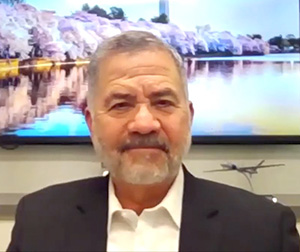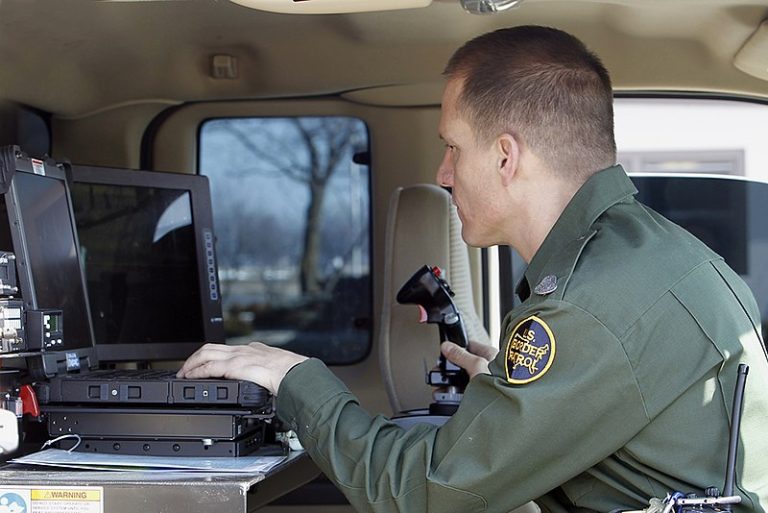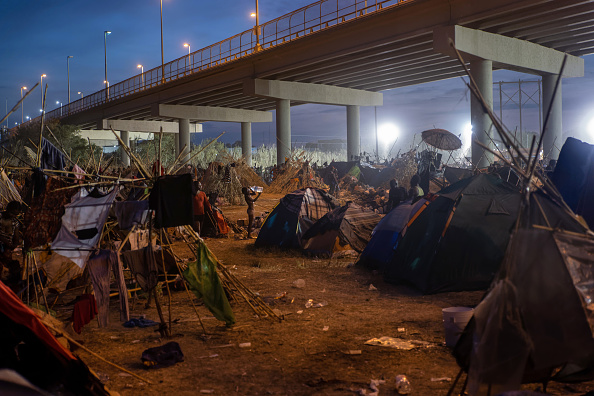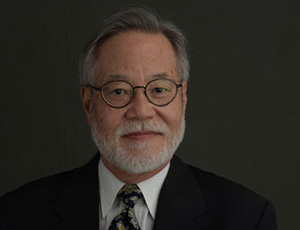Views expressed by any party interviewed by Ideaspace are those of the interviewee and are not necessarily shared by Ideaspace.
The following is a transcript of the video briefing above, lightly edited for clarity and presented here to enable users to search the participants’ comments.
DW Gibson:
Today, we’ve returned to the topic of border security. More specifically, what tools are available to the US to address crises before they materialize at the border? We welcome Ben Rohrbaugh to the Ideaspace Briefing series to help us address these questions. Mr. Rohrbaugh is part of the team at New Macro Risks, which is a developer of Homeland Security and emerging risk training products. He’s also the co-founder of Lantern Unmanned Autonomous Systems, which develops systems to scan cargo containers using aerial drones. Ben brings years of academic and governmental experience to his work in the private sector. He’s been a fellow at the Central America and Mexico Policy Initiative at The Robert Strauss Center for International Security and Law at the University of Texas at Austin. He was previously a senior advisor in the Department of Homeland Security Office of Policy. And from 2014 to 2016, he served as the Director for Enforcement in Border Security at the National Security Council in the White House. He’s also served as a senior advisor to the Commissioner of Customs and Border Protection, with much of his work focusing on border management, cross-border infrastructure, and communications interoperability. We’re glad to have you with us today, Ben.
Ben, I know New Macro Risks, as the name implies, takes a look at the big picture. And with that in mind, I wonder what are some of the concerns around the world that you see affecting border security specifically — perhaps some of the newer, less traditional risks that might not be so obvious?

Ben Rohrbaugh:
Sure. Thank you so much, DW, and it’s a pleasure to be here with everyone. I think what we are seeing, particularly in terms of what’s driving migration, is that some of the risks that may have been prevalent in the past have changed in their intensity and in the way that they’re directly affecting flows. We’ve certainly seen escalating natural disasters causing very direct consequences in terms of people wanting to move and needing to move from their homes. But we’re also seeing an escalation in the way that transnational organized crime is affecting the decision of civilians to migrate. We see this particularly in Central America, and also in places like Venezuela, where really extreme levels of danger to civilians and challenges to national sovereignty are causing migrants to flee and claim asylum in ways that are really untraditional, or really outside of the traditional pathways where people face political persecution. And now, it’s very frequently a question of people feeling unsafe in their communities because of gangs and organized crime at a level that just generally hadn’t been realized in the border in the past.
DW Gibson:
And you mentioned national sovereignty there. I know that makes me think of the post-9/11 framework, and I know that border security has changed a lot over the last couple of decades. 9/11 was a big watershed moment, right? That’s where we folded the idea of border security into war on terror and militarization of the border. But it feels as though we’ve reached a, if you will, post-post-9/11 stage, whereby the go-it-alone approach feels a little bit inadequate for the challenges that we’re facing on a global scale. How do you think we might adjust this post-9/11 framework that we’ve been using for the last couple of decades?
Ben Rohrbaugh:
Sure. So specifically as it relates to the border, after 9/11, there was a huge focus on intercepting entries on the southwest border. It was understood that we didn’t have a complete sense of who might be crossing the southwest border, and so the possibility of a terrorist or terrorist group entering in between the ports of entry and entering the United States without being detected was very, very prominent on policymakers’ minds after 9/11 and as the Department of Homeland Security was being formed.
It also, though, coincided with a huge push for border security generally, which had begun in the 1990s. The border patrol had been doubled in the 1990s and then was doubled again in the early 2000s. And that was almost entirely focused on this problem of intercepting illicit migration at the Southwest border — so, people crossing in between the legal ports of entry and trying to get around border patrol agents.
And what we’ve seen since 2013 is that the problem has fundamentally changed, as I’m sure many folks here know well. Instead of having primarily Mexican migrants who are moving across the border and evading border patrol agents, we have much, much larger numbers of families, children, and other vulnerable populations that are actually seeking out border patrol agents and claiming humanitarian protections, which is really an entirely different problem and one where the structures of sensors and cameras and overhead drones and other things that were put in place after 9/11 to provide situational awareness on people crossing, aren’t as effective because people are not, to a large extent, trying to evade apprehension. Or if they are evading apprehension, they’re actually enabled to do that better because border patrol agents are so busy handling straightforward processing of people who are presenting themselves to them. So I think what we’ve seen is that the border security enterprise that was constructed in the nineties, and then accelerated after 9/11, hasn’t been the best fit for the challenges that we’ve seen in the last eight or nine years.
DW Gibson:
I think that’s an important point of distinction you’ve made there in terms of the responsibilities eating up the time of border patrol agents. It’s not so much about surveillance and keeping an eye on land masses between ports of entry, but rather about processing, this bureaucratic work that they weren’t doing nearly as much a few decades ago. I know that you work closely with Alan Bersin in a few different capacities. He’s involved with New Macro Risks, he’s a former CBP commissioner. And he talks a lot about migration management and the idea that all of those tools that you just referenced — drones and surveillance and barriers — are part of managing the border, but that’s really just one piece of border security. The other piece is what you’ve been touching on here at the beginning of our conversation, taking a wider look at what we can do to intercept traffic before it gets to the border. I’ve heard him talk about how the border is often misconstrued as a first line of defense when really, it’s a last line of interaction. There’s so much that happens, as you’ve indicated here, before people get to the border. So with that idea of migration management there in the center of things, I wonder if you could talk to that idea a bit more, migration management, what it means to you, and how you see it possibly playing out when it comes to border security policymaking.
Ben Rohrbaugh:
Yeah, that’s a great point. That’s a great segue. So a lot of these discussions about migration management can get very technical, right? People start talking about specific programs and different aspects of it, MPP [the Migrant Protection Protocols] and this and that, and it gets very quickly bogged down in technical details.
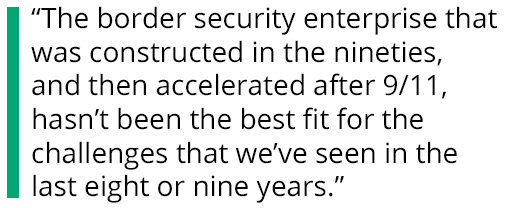 But I think fundamentally when we’re thinking about migration management questions, we’re thinking about people, and there are a few different things that need to be decided in order to find solutions. So as people are moving, their needs need to be met somehow. Either they’re going to be fed and sheltered through some sort of formal mechanism, or they’ll use informal mechanisms as they’re traveling. They have some kind of legal status as they’re moving through these migration pathways, whether it’s an illegal status where they’re not allowed to be somewhere, or whether they have some sort of temporary status or whatever it is. And they need some process where that could be adjudicated, right? And finally, if there’s going to be some kind of migration enforcement, we need to determine where they’re going to go.
But I think fundamentally when we’re thinking about migration management questions, we’re thinking about people, and there are a few different things that need to be decided in order to find solutions. So as people are moving, their needs need to be met somehow. Either they’re going to be fed and sheltered through some sort of formal mechanism, or they’ll use informal mechanisms as they’re traveling. They have some kind of legal status as they’re moving through these migration pathways, whether it’s an illegal status where they’re not allowed to be somewhere, or whether they have some sort of temporary status or whatever it is. And they need some process where that could be adjudicated, right? And finally, if there’s going to be some kind of migration enforcement, we need to determine where they’re going to go.
And I think what you were referencing in Alan [Bersin]’s point is that, in the 1990s and the early 2000s when the United States was dealing mostly with Mexican migration, those were pretty easy questions. When someone was removed, they were removed back to Mexico. Did they have legal status in the United States? No. And they largely didn’t have the ability to appeal for humanitarian protections in the United States. The question of how their needs were met, how they were sheltered, was entirely through informal mechanisms. You arrived at the border — maybe you paid a coyote. If you managed to evade apprehension, you moved into informal employment networks. And suddenly, you were working in one of these different industries like construction or restaurants or other things that really have used high levels of illegal labor in the United States.
But what we’re seeing now is that those questions, which were so simple or so comparatively straightforward in the previous context, are much more complicated now. We’re seeing large numbers of Central Americans, we’re seeing children, vulnerable populations, and increasingly in the last few years, we’re seeing arrivals of migrants from places where we can’t return people, places like Venezuela or Cuba or Nicaragua. The question of where they go after some kind of legal determination of their status is made is entirely up in the air.
And I think what that results in is that suddenly, policymakers need to start thinking about migration far beyond just when migrants arrive at the southwest border. They need to think of the whole pathway that people use to get to the United States. And we’ve actually seen that. We saw it in the Obama administration and we saw it in the Trump administration where, despite very different pathways, they ended up settling on really similar solutions to the migration surges that they faced. And in both situations, it was to turn to the Mexican government. With the Obama administration, it was to turn to the Mexican government and ask them essentially to increase enforcement on Mexico’s southern border with Guatemala and Belize. And in the Trump administration, it was to establish the Migrant Protection Protocols, which put people in Mexico, but also to push the Mexican government to increase their enforcement with a threat of tariffs. So, very different interactions with the Mexican government. But fundamentally, it was a way to try and solve the problem outside of the United States, which is, I think, the core of what you’re getting at, DW, that suddenly these problems can’t just be solved at the physical land border of the US.
DW Gibson:
You touched on the idea of these long journeys that a lot of migrants are making — hundreds, and in some cases thousands of miles. And I think something that often gets overlooked is the danger of that journey, and looking for ways to possibly shorten that journey or preempt that journey. For two reasons: one, to help the migrant not be put in danger’s way, but also to not create chaos at the border in terms of large surges of people that we see in episodic fashion. And I know that when you and I first spoke, we were talking about… I guess I might characterize this as the semi-novel idea of regional processing centers. The notion that some of the work of making determinations of where a person can wind up could possibly happen before people reach the southern border. It’d be interesting to hear you talk about that idea in broad strokes. Paint a picture of what it might look like, and the importance of international cooperation in such an approach.
Ben Rohrbaugh:
So I think that the core problem that we have to address, which regional process centers or something like that are a promising approach for, is that right now, the United States effectively has two different immigration systems. There’s one if people arrive at the southwest border where they’re eligible to make certain kinds of claims for humanitarian protections that they wouldn’t be able to make if they arrived at a consulate or went through any kind of formal process. And that, obviously, has significant downsides in terms of what it means to manage migration, but also in terms of the incentives it creates for migrants to use basically illicit pathways to the southwest border and subject themselves to all kinds of really awful treatment.
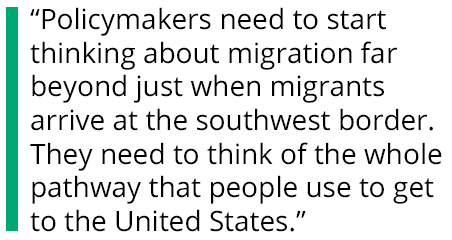
But I think what that also shows is that in order to move away from having this separate, informal migration system at the southwest border that’s based on use of asylum claims is that, if we’re able to provide a way, working with our partners in their region, for migrants to actually make claims for humanitarian protections, and for the people who do have very legitimate needs for those kind of protections to be safe while they go through some sort of expedited legal process where they don’t necessarily have to be waiting in the United States while that happens — that could be a way to, one, make the process more orderly and prevent some of the problems we’re seeing that overwhelm the existing systems at the southwest border, but also to provide access to humanitarian protections to the people who are most vulnerable.
And I think what is often obscured here is the people who are most vulnerable in a place like Guatemala or El Salvador are not necessarily the people who are able to pay thousands of dollars for a smuggler to take them to the southwest border. It’s often the people who don’t have those kinds of resources. And so, this question of who are the people who are most in need of humanitarian protections, how we can actually provide access to those [protections], how we do that in the region, and how we can use that as a way to establish an orderly system that provides protections to people who genuinely deserve it [without creating] a separate, informal immigration system that people can take advantage of is really, I think, the core policy question that officials are grappling with in migration.
DW Gibson:
Well, and one of the reasons I think the idea of a regional processing center is so appealing is because it scrambles political positions. It’s hard to have a quick reaction to it because on the one hand, it gives both parties, people across the political spectrum, something they’re looking for. It saves people from long, dangerous journeys and it could potentially take at least some pressure off from some of the surges we see episodically at the border. And it also creates a sense of shared responsibility regionally in terms of addressing migration, so we can alleviate some of the pressure that the US feels going at it alone, so to speak.
And I also think there are some unexpected outcomes. And maybe if you could speak to those in terms of things we don’t consider when migrants are trying to find a place to live, in terms of language, in terms of cultural similarities, other choices they might have beyond just coming to the US. So maybe touch on that. And also, I think it’s important for policymakers, when trying to consider these more novel ideas, to look at things that are already out there in the landscape that might provide some modeling. I know there have been some very limited small programs, CAM [the Central American Minors program] and so forth for unaccompanied minors. Talk to some models that are out there that could be looked at and maybe built up to look at this idea of regional processing centers.
Ben Rohrbaugh:
So I think this gets back to the point I made earlier about how we can either have formal processes to meet migrants’ needs as they’re traveling, or we can have informal processes. And that’s what we have now, and they’re largely exploitative and bad, right? You don’t want the situations that we’re seeing where there are informal camps or things like that, where they’re overwhelming cities in Mexico. Certainly we’ve seen during the pandemic that you don’t want large areas where people don’t have any access to medical care, where there are sicknesses and other things that can spread quickly. All of those things are fraught and dangerous and have all kinds of serious policy consequences.
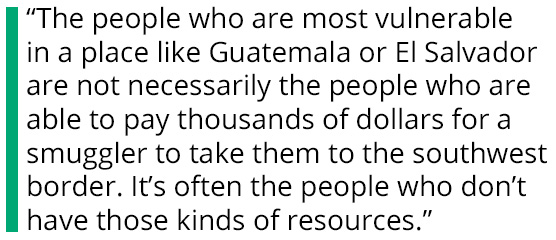
And what is interesting about a real regional approach to migration is that everyone doesn’t necessarily have to end up in the United States in one of these models. You could have a situation where migrants who genuinely are fleeing danger in whichever country they’re coming from and who really merit humanitarian protections could be… Maybe some people could be placed in the United States. Some people could be placed in other Spanish-speaking countries in the region. There may be people who would be safe and comfortable in Chile or wherever else. You’d have to work this out with foreign governments, and obviously they would need assistance as they’re working to integrate these asylum seekers into their populations. But it’s certainly achievable and doable. And I think that the commerce of this is that the way we’re doing things right now is about as expensive and burdensome as it could possibly be. When you look at expenditures on the southwest border, what it means to quickly build shelters for DHS or Health and Human Services, the way money is moving for these kinds of things, it’s an incredibly expensive and difficult process.
And so, if there were a way to be a little bit more thoughtful about it to try and establish some kind of actually regional approach where people would genuinely have access to make humanitarian claims, but where people who are economic migrants wouldn’t necessarily be able to wait in the United States for years while those claims are adjudicated as they often are now, that kind of approach, I think, could really be valuable. And like you said, it gets away from some of the previous political scar tissue around this. I mentioned both the Trump administration and the Obama administration turned to the Mexican government at some point. And they did it in very different tones, but that’s where they ended up. And I think that’s likely where we’re going to continue ending up with these future crises, especially as we start seeing populations arriving from broader and broader geographic areas as we are now.
DW Gibson:
Yeah. And thank you for underscoring that, because I think that point that both the Obama administration and Trump administration, in effect, did the same thing speaks to the reality that we’re facing and the reality that we’ve been talking about here in terms of a need to address things in a, not a go-it-alone approach, but a more expansive approach. Let’s talk a little bit about data too, because I know that there’s a lot of perspective around the importance of data and how it can inform border security, whether it’s an acute version of data in terms of images, sounds, and movements captured at the border with some of the tools you mentioned at the outset of our conversation, but also data as it applies to migratory movements, right? So just in broad strokes, as an opening question on this topic, talk about sort of how you see data as an important tool when it comes to border security.
Ben Rohrbaugh:
Yeah. So I’d say it in maybe two pieces. The first is that getting situational awareness on the border has actually been an enormous challenge for the Department of Homeland Security and its predecessors. There’s this major famous acquisition initiative, SBInet [the Secure Border Initiative Network], right? The idea of this virtual border wall is the case study you use in failed DHS acquisitions [of goods or services. The case study shows how] networks of contractors and subcontractors, all doing complicated things, eventually don’t work very well. And I think because of that, there’s been a lot of resistance to comprehensive solutions on the southwest border with the result that you generally have operators in a piecemeal way using whatever works for them.
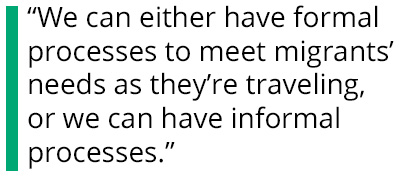
And I think folks are often surprised, if you go talk to DHS or CBP and say, “All right, show me the southwest border.” And it’s like, well, all right, give our folks a couple hours to come up with a presentation of it for you. It’s not what you imagine where you walk into a boiler room and you can see everyone who’s moving anywhere in the border. And so, that’s an ongoing challenge and one where I think there are technological solutions that exist, but ones that just haven’t been applied quite as thoroughly as they need to be. But on top of that, there’s this much bigger challenge of figuring out what’s going to happen in the future and what data is most relevant about where migration is going. And I’ve seen a number of different efforts to try and provide some kind of predictive indicators about what’s going to happen with migration.
That’s when I was in the government. I’ve seen it outside, and it’s incredibly challenging because there are so many different things that can affect how people choose to migrate. And so, what generally happens is folks will say, all right, well, we need some kind of model to figure out what’s going to drive people to come to the US. They say, all right, well, natural disasters, right? People are going to want to migrate after some terrible disaster in the area. And that’s sort of true, but then you’ll have situations like the earthquake in Haiti where there’s an earthquake, people leave Haiti, but then they go to Brazil for a couple years, and then eventually, it’s a policy shift in the United States that actually results in large numbers of… or a perceived policy shift in terms of removal flights [after natural disasters] that actually results in lots of people arriving in Del Rio.
How do you model that? How do you model perceptions of policy changes or other things? This is a major challenge, and one that I wouldn’t necessarily want to be the person who has to figure out. But it’s one where as folks are making decisions about how resources are allocated and how policies are changed, they do need better information and better indicators than they have now. Because, I mean, I think many folks here have seen, if you just take, well, here’s how many apprehensions or encounters in the border we have now and say, okay, well, let’s overlay some scenarios. If it increases as much as this year, it’ll go up by this much. But if it drops as much as this year, it’ll go down this much. Then maybe you add a seasonal variation. That’s not that informative. And it particularly isn’t useful two years from now, three years from now, five years from now, right, as you’re thinking about budgeting cycles. So this question of how you get better data about migration is very much open.
And one last thing, sorry. I’m going on about this, but the last thing is figuring out how you actually really incorporate relevant data from sending and transit countries is the biggest missing piece of this, in my perception. How do you actually figure out when people are moving through Panama and how these shifts are happening?
DW Gibson:
So it sounds like you’re a little skeptical of the gaming-out scenarios, right, in terms of trying to be predictive. We’re not quite there yet or don’t quite have a handle on that. And it sounds like baked into what you’re saying is that the best way we can utilize data at this point is also looking back at scenarios we’ve dealt with and trying to see what we can possibly learn from scenarios that have already played out. I wonder if there are some examples that come to mind that might be good to look at in that regard. I know in an earlier conversation we had, you mentioned an example with a mini surge of Indian Sikhs in 2011.
Ben Rohrbaugh:
Yeah. So I think what is limiting in a lot of these is that if you’re just looking at what’s happened in the past, you’re looking at primarily Mexican migration and then you’re looking at Central American migration over the last eight years, but none of that would’ve been predictively useful in figuring out Venezuelan migration in 2022 because it’s largely a new phenomenon, right? Well, over the past decade or so, we’ve known that lots and lots of Venezuelans were being displaced from their home and they were moving around largely South America, but they weren’t coming to the United States. And now, they’re starting to right now. Now we are seeing significant numbers of people arriving. And it’s not totally clear why. It’s not just a strict cause and effect, right? People want to leave Venezuela and they show up at the southwest border. There are other things going on.
And to the example that you mentioned, in 2011, there was this minor surge. It was a few thousand people, but it was of Indian nationals arriving at the southwest border and they were claiming asylum protections and they were all using the exact same story. They were saying they were Sikhs and they’d been persecuted… I mean, the exact same story. It was, they had been married to someone from another religion and they were persecuted in their community. And they would meet the CIS Credible Fear threshold and then were put into the immigration court process. And at the time, this was before a lot of the huge surges of Central American migrants at the southwest border, so it was almost an oddity. I mean, everyone watched it closely, but it was pretty clearly some sort of human smuggling network. I think when they traced it back into India, this company had billboards. Travel to the United States, no visa needed. Which in a way was true.

And so, I think what is important to bear in mind is that the model that we’re seeing right now where migrants essentially scrape together money or use debt to pay a smuggler to get to the United States, then have to repay the smuggler with their earnings once they arrive, and where they’re moved through human smuggling networks and where they claim humanitarian protections, that has, to this point, mostly been Central American migrants. Now we’re seeing some other South American migrants, certain populations, Caribbean populations. But that model can scale. We don’t know how much it can scale to people in other parts of the world who could potentially afford or be able to go into debt for a plane flight into Mexico or Guatemala or Panama. And we know lots and lots of people would like to have access, would like to be able to come to the United States. But really, the fact that people might be able to use a pathway but haven’t used it yet, doesn’t mean, of course, that they’re not going to.
And so, I think it’s very possible that we could see very different kinds of migrants arriving and presenting different challenges. So the kind of migrants that are right now crossing the Mediterranean on boats or other kinds of groups arriving at the southwest border. I don’t know, I wouldn’t want to make a prediction for whether Libyans are going to start arriving in the United States in the future. Who knows? But I think what we can do now very much is figure out, well, what actually would that mean? What would these scenarios mean on the southwest border? Where are the gaps in our policy processes or our ability to process these different populations? What would it mean if we had lots more people arriving who we weren’t able to return? Where would they go? Would they wait in Mexico? Would they wait somewhere else? Would we provide resources to create some kind of safe zone where they could wait in Mexico? Or would it be something where we just say, this is the Mexican government or the Guatemalan government’s problem? They just get stopped as they’re starting to move across. Those are all, I think, very much open questions and should be addressed. And these are the kind of things that, I think, it’s valuable to think about right now.
DW Gibson:
Yeah. And you mentioned fees paid to smugglers and so forth. I mean, we’re talking about what’s become a massive industry, right? Billions of dollars put into that sort of black market, if you will. And you spoke to the fact that there are some migrants who can’t afford to do that, right? And those are the people that are really left out of this conversation. But I think the fact that we do have such a large illicit industry demonstrates that there are some resources that could be put into a legitimate industry of processing. Again, just going back to the regional processing center idea, fees and so forth could, in some cases, be manageable for migrants and a much better use of resources, a much safer use of resources, no?
Ben Rohrbaugh:
Yeah. I think we have this surprising, unintended consequence of the level of border security investment on the southwest border where if you’re actually going to evade apprehension on the southwest border, you now have to hire a skilled guide. And it’s reaching the kind of prices that it used to be if you wanted to get taken to Canada on a ship and then smuggled across the border. The costs we’re seeing, the amount of money we’re seeing people start to pay on the southwest border, are much, much, much higher than it was even in 2011 or something like that. And so, it’s supporting a much more sophisticated human smuggling network and it is enabling people to go farther distances. And we don’t really know where it ends, but you’re right. It’s become a real industry and one where responders are much more sophisticated. And so, it’s just not clear how much more this could scale, but it could be a lot. And I think that’s really worth thinking through. Yeah.
DW Gibson:
Do you have any sense, in terms of that scale that we’ve already seen in terms of what people are paying, can you put any specs on that? Or at least any estimates from your work in terms of what we see in terms of fees people are paying?
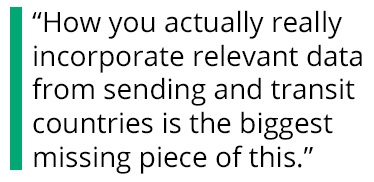 Ben Rohrbaugh:
Ben Rohrbaugh:
Yeah. From Central America, you’ll hear estimates in the $7,000 plus range. For other places, I think when Indian nationals were arriving in 2011, those people are paying tens of thousands of dollars, $30,000 or more to be smuggled. And so, it varies quite a bit, but I think the numbers are going up. A large amount of that is involved in payoffs along the way to different organizations. And so, you’re dealing with these… These organizations that want to capitalize on it, right? They’re very entrepreneurial. And so, as numbers go up, they have a big incentive to try and extract more and more of the cost of being paid by migrants.
DW Gibson:
Yeah. Well, and you’ve mentioned asylum a few times and I realize that’s its own topic and can of worms. But even this aspect would be good to hear you talk about, in terms of how use of that system has grown exponentially in the last decade, I think the last decade was up over 400% in terms of claims. So maybe talk about that and how things get shoehorned into that, right, and if you see any ways for us to de-incentivize that approach that we see so many migrants take.
Ben Rohrbaugh:
Yeah. So the asylum system has become almost a separate immigration system on the southwest border. And I think for a lot of migrants, it’s really their only viable path to living in the United States. Certainly for a lot of Central Americans and some other countries. Because the legal pathways are slow and there are country caps, right? And a lot of these processes are forbidding to people who don’t have the resources. But the asylum system is broadly… right now, because it’s so overwhelmed, if you can get to the United States, if you meet certain demographic criteria and are enabled to go through an immigration court process, that process is so backed up. You’d be in the United States for years, right? I mean, immigration court hearings now are famously five years out. More sometimes, right?
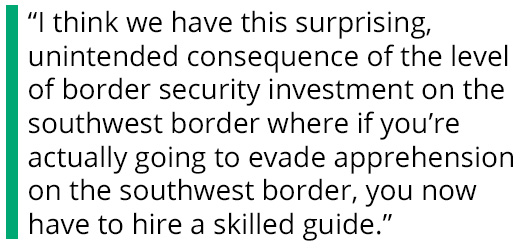 And so, what we’ve seen is that a process that is important… people need to be able to make claims of humanitarian protection. Largely, the modern asylum system comes from post-World War recognition that the things that happened, like boats full of Jewish refugees being turned away and returned to Europe, were terrible and can’t happen again. So there clearly does need to be a way for people who physically arrive at the US to make some kind of claim for protections. But what we see now is that, on the southwest border specifically, the ability of people to travel there in much, much higher numbers than they have in the past, and then make those claims, plus the fact that the system is so backed up, has created what is effectively an informal… It’s not informal because it deals with government processes, but it’s created an alternative migration system that is disorderly and where people can stay in the United States for large amounts of time without really having any kind of official status. And then, they can hope that either there will be some kind of change in the laws later or there’ll be some sort of change in enforcement priorities and they won’t be removed. And largely, that’s often the case.
And so, what we’ve seen is that a process that is important… people need to be able to make claims of humanitarian protection. Largely, the modern asylum system comes from post-World War recognition that the things that happened, like boats full of Jewish refugees being turned away and returned to Europe, were terrible and can’t happen again. So there clearly does need to be a way for people who physically arrive at the US to make some kind of claim for protections. But what we see now is that, on the southwest border specifically, the ability of people to travel there in much, much higher numbers than they have in the past, and then make those claims, plus the fact that the system is so backed up, has created what is effectively an informal… It’s not informal because it deals with government processes, but it’s created an alternative migration system that is disorderly and where people can stay in the United States for large amounts of time without really having any kind of official status. And then, they can hope that either there will be some kind of change in the laws later or there’ll be some sort of change in enforcement priorities and they won’t be removed. And largely, that’s often the case.
So we’ve created a system … or we haven’t created, we’ve allowed a system to be created with all kinds of, really, the wrong incentives. It’s not anything that I think almost anyone across the political spectrum would want, but that’s what we have now. And I think it is important to recognize that the asylum system needs to be reformed without violating our basic obligations to have access to humanitarian protections for the folks who need it the most. And that’s where I think we need to think a little creatively and get beyond the existing approaches we’ve used.
DW Gibson:
Yeah. Well, I think that our initial conversation that you and I had several months ago about regional processing centers is one of those creative ideas. And I encourage all of our viewers to check out what we call our Strategic Inquiry No. 6 where we looked at that idea, because I think it is a really good one. And Ben has a lot of good input in that essay in terms of de-incentivizing these dangerous journeys that people make that overwhelm our system and providing an alternative way of processing things in a cooperative manner that takes some of the pressure off the US and helps us build regional partnerships. Ben, I think we’re out of time, and I’m so grateful to you for giving us your perspective today on this topic. And I hope we see you again soon.
Ben Rohrbaugh:
Thank you so much. It was a pleasure.
